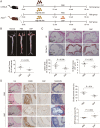Serum amyloid P component therapeutically attenuates atherosclerosis in mice via its effects on macrophages
- PMID: 29930724
- PMCID: PMC6010983
- DOI: 10.7150/thno.22704
Serum amyloid P component therapeutically attenuates atherosclerosis in mice via its effects on macrophages
Abstract
Background: A hallmark of atherosclerosis is the formation of macrophage-derived foam cells. Serum amyloid P component (SAP), a member of the pentraxin family of proteins, is known to affect macrophage activation. However, the role of SAP in atherosclerosis is still unclear. Methods: Apolipoprotein E-deficient (Apoe-/-) mice fed a high-fat diet were given intraperitoneal injections of SAP (6 mg/kg) every other day for a total of 2 weeks to characterize atherosclerosis development. Results: We showed that intraperitoneal injection of SAP attenuated atherosclerosis in Apoe-/- mice. Immunostaining of aortic roots indicated that SAP was up-taken by the lesion area. In SAP-treated mice, serum paraoxonase1 (PON1) activity was increased whereas high-density lipoprotein inflammatory index (HII) was reduced. The cholesterol efflux rate in macrophages was elevated along with the expression of cholesterol efflux proteins. Through bioinformatics analysis followed by experimental validation, we found that proline/serine-rich coiled-coil protein 1 (Psrc1) was an important downstream effector of SAP in macrophages. Conclusions: Our findings reveal an anti-atherosclerotic role of SAP and extend the current knowledge regarding this molecule as a marker for atherosclerosis.
Keywords: atherosclerosis; cholesterol; macrophage; serum amyloid P component.
Conflict of interest statement
Competing Interests: The authors have declared that no competing interest exists.
Figures





Similar articles
-
SAP deficiency mitigated atherosclerotic lesions in ApoE(-/-) mice.Atherosclerosis. 2016 Jan;244:179-87. doi: 10.1016/j.atherosclerosis.2015.11.009. Epub 2015 Nov 23. Atherosclerosis. 2016. PMID: 26649902
-
PSRC1 overexpression attenuates atherosclerosis progression in apoE-/- mice by modulating cholesterol transportation and inflammation.J Mol Cell Cardiol. 2018 Mar;116:69-80. doi: 10.1016/j.yjmcc.2018.01.013. Epub 2018 Feb 3. J Mol Cell Cardiol. 2018. PMID: 29378206
-
Serum amyloid P attenuates M2 macrophage activation and protects against fungal spore-induced allergic airway disease.J Allergy Clin Immunol. 2010 Oct;126(4):712-721.e7. doi: 10.1016/j.jaci.2010.06.010. Epub 2010 Jul 31. J Allergy Clin Immunol. 2010. PMID: 20673988
-
The Development of Serum Amyloid P as a Possible Therapeutic.Front Immunol. 2018 Oct 16;9:2328. doi: 10.3389/fimmu.2018.02328. eCollection 2018. Front Immunol. 2018. PMID: 30459752 Free PMC article. Review.
-
Serum amyloid P: a systemic regulator of the innate immune response.J Leukoc Biol. 2014 Nov;96(5):739-43. doi: 10.1189/jlb.1MR0114-068R. Epub 2014 May 7. J Leukoc Biol. 2014. PMID: 24804675 Free PMC article. Review.
Cited by
-
Proteomic analysis of carotid artery plaques with and without vulnerable features on magnetic resonance angiography with vessel wall imaging: a pilot study.JVS Vasc Sci. 2025 Jan 21;6:100281. doi: 10.1016/j.jvssci.2025.100281. eCollection 2025. JVS Vasc Sci. 2025. PMID: 40034248 Free PMC article.
-
Proteomic Studies of Blood and Vascular Wall in Atherosclerosis.Int J Mol Sci. 2021 Dec 9;22(24):13267. doi: 10.3390/ijms222413267. Int J Mol Sci. 2021. PMID: 34948066 Free PMC article. Review.
-
Endothelial to mesenchymal transition contributes to nicotine-induced atherosclerosis.Theranostics. 2020 Apr 6;10(12):5276-5289. doi: 10.7150/thno.42470. eCollection 2020. Theranostics. 2020. PMID: 32373212 Free PMC article.
-
A Proteomic Study of Atherosclerotic Plaques in Men with Coronary Atherosclerosis.Diagnostics (Basel). 2019 Nov 7;9(4):177. doi: 10.3390/diagnostics9040177. Diagnostics (Basel). 2019. PMID: 31703357 Free PMC article.
-
Potential plasma biomarkers at low altitude for prediction of acute mountain sickness.Front Immunol. 2023 Sep 28;14:1237465. doi: 10.3389/fimmu.2023.1237465. eCollection 2023. Front Immunol. 2023. PMID: 37841248 Free PMC article.
References
-
- van den Blink B, Dillingh MR, Ginns LC, Morrison LD, Moerland M, Wijsenbeek M. et al. Recombinant human pentraxin-2 therapy in patients with idiopathic pulmonary fibrosis: safety, pharmacokinetics and exploratory efficacy. Eur Respir J. 2016;47:889–97. - PubMed
Publication types
MeSH terms
Substances
LinkOut - more resources
Full Text Sources
Other Literature Sources
Medical
Research Materials
Miscellaneous

